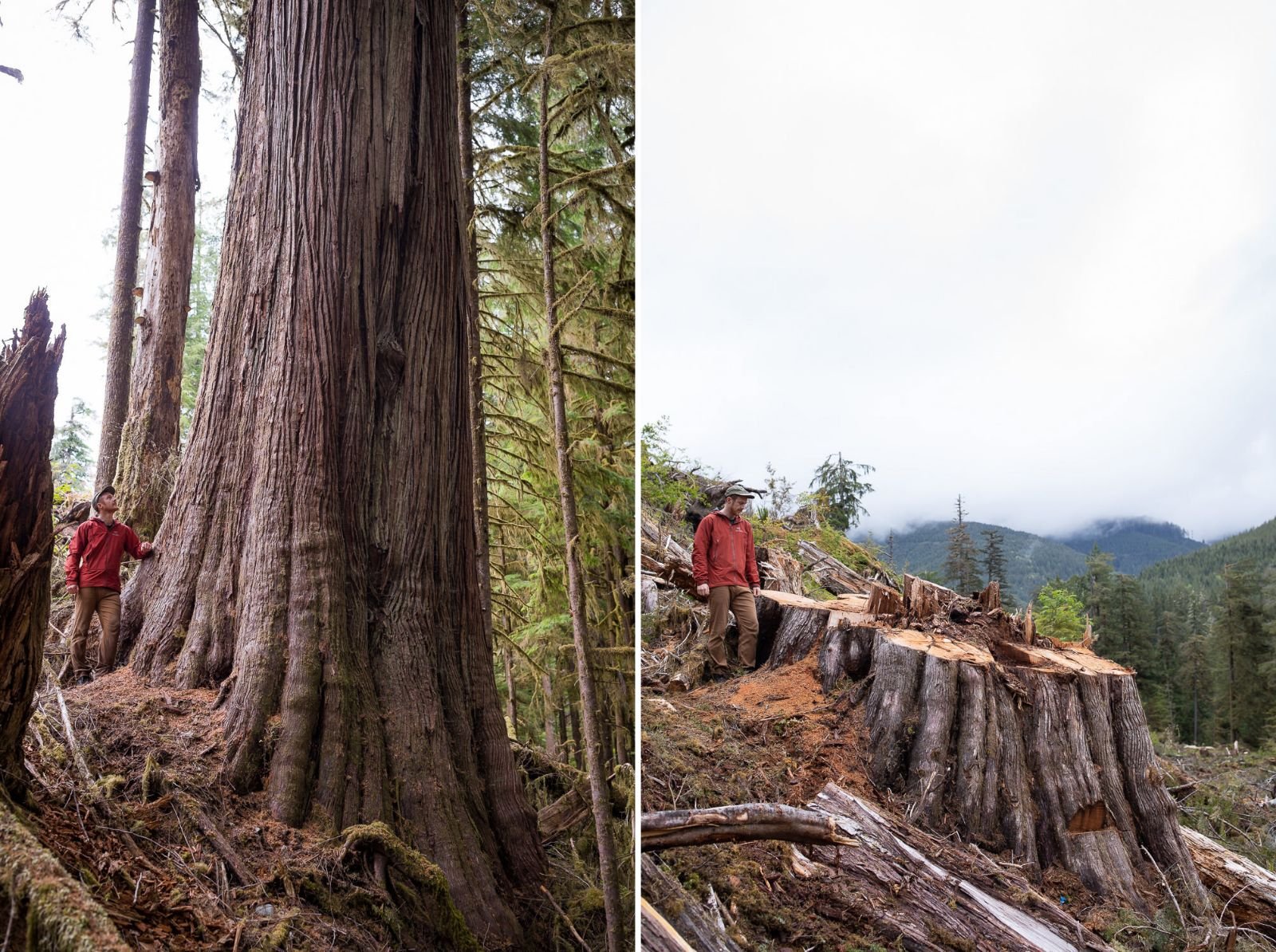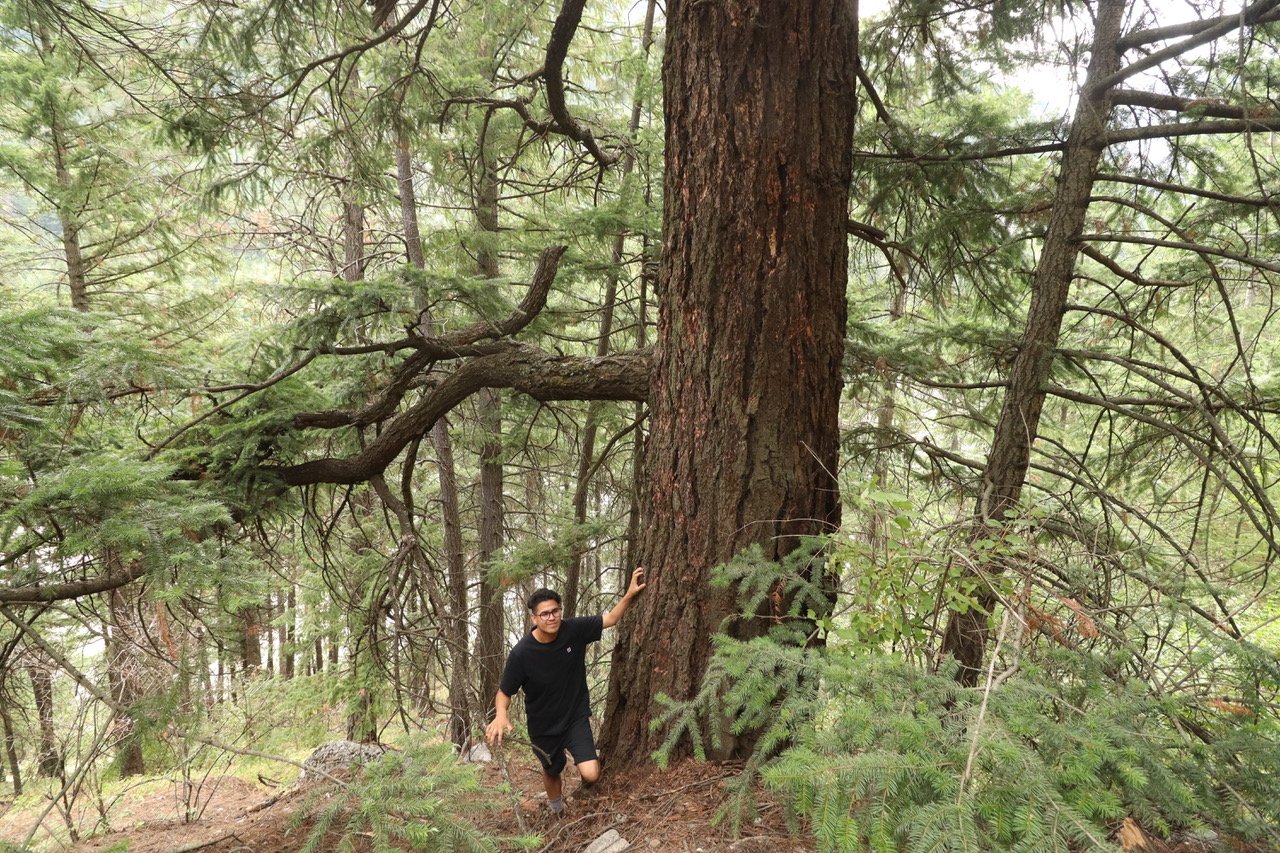This year, EEA is aiming to raise $30,000 in grassroots fundraising by Environment Day June 5th, 2023. These funds will help us in making a series of mini-documentary films on the amazing, most endangered ecosystems across Canada, drafting key environmental legislation with lawyers and ecologists, undertaking major outreach to businesses, unions and faith groups, and undertaking major public mobilization nationally and across Canada to ensure politicians hear from Canadians on the need to expand the protected areas system with an emphasis on the most endangered ecosystems.
Read moreHow a new ‘nature economy’ is transforming the fight for B.C.’s ancient forests (Global News)
Have you ever seen a tree so big it would take 10 people to wrap their arms around its trunk – and that still wouldn’t be enough? A tree as tall as a downtown office building?
These trees exist and, in British Columbia’s coastal rainforests, are measured and even tracked by the people fighting to protect them.
Read moreNew Video: BC Old-Growth Policy Update - February 17, 2023
Here's a new video by the EEA's Executive Director Ken Wu on a BC Old-Growth Policy Update **Note: it was filmed before the new forest policy progress announcements by Premier Eby a couple days ago, which we have included in the write-up below. Please watch and SEND a MESSAGE to the BC and federal governments asking them to keep moving forward at: https://www.endangeredecosystemsalliance.org/news/bc-needs-an-effective-federal-provincial-nature-agreement
The short summary: The new BC Premier David Eby is undertaking major and much needed policy overhauls to develop the framework and funding that will enable a massive expansion of protected areas in BC shortly, via First Nations initiatives (***NOTE: in BC, the province legally cannot unilaterally establish protected areas and "just protect the old-growth" - the support of local First Nations governments is a legal necessity in their unceded territories. Old-growth logging deferrals and protected areas move at the speed of local First Nations - the government's policies and framework can facilitate or hinder, help speed up or slow down, the abilities of First Nations to protect ecosystems, if they choose. This is a vital fact to understand for conservation and old-growth advocates).
Read more‘The right direction’: new B.C. plan could actually protect old-growth forests (The Narwhal)
A “war in the woods” has simmered for decades in B.C., sometimes erupting into high-profile protests and arrests over plans to log ancient trees in places like Clayoquot Sound and Fairy Creek.
This week, the provincial government unveiled a suite of new measures that aim to accelerate old-growth protection and broker a truce. Measures include new initiatives to finance old-growth forest protection, more Indigenous participation in land-use decisions and an end to prioritizing timber extraction over all other values, including biodiversity and carbon storage.
Read moreB.C. moves to fast-track its overdue old growth protection commitments (The Globe and Mail)
B.C. Premier David Eby speaks during a news conference in Vancouver, on Feb. 5. The NDP government made a commitment in the 2020 election campaign to protect old growth – officially recognizing that the value of old-growth trees left standing can be far greater than the value of those trees as timber products. (Darryl Dyck/The Canadian Press)
The B.C. government is seeking to harness the financial clout of non-profit conservation groups to protect endangered ecosystems, with a commitment to create a new trust fund to leverage charitable donations for nature with its own dollars.
Premier David Eby announced on Wednesday his plans to fast-track his government’s progress on protecting old growth, including $25-million to help First Nations participate in land-use decisions on old-growth forests, and $90-million added to the B.C. Manufacturing Jobs Fund to help forestry companies retool their mills to adapt to second-growth timber.
Read moreMedia Release: The BC government starts laying the path for expanded forest conservation
Kanaka Bar Indian Band Lands Manager Sean O’Rourke and Junior Land Guardian Domonique Samson stand by an old-growth Ponderosa pine tree in the band’s T’eqt’aqtn’mux Indigenous Protected and Conserved Area (IPCA) proposal, which is being supported by the Nature-Based Solutions Foundation, Endangered Ecosystems Alliance and Ancient Forest Alliance. About 125 square kilometers of old-growth forests will be encompassed by the IPCA when finalized.
The BC NDP government has removed the “unduly restrict clause” from forest planning that has limited forest conservation measures for decades, committed to developing a conservation financing mechanism to support First Nations economic development linked to new Indigenous Protected and Conserved Areas (IPCA’s), committed more support to expand value-added forest industries, and with First Nations has added about 200,000 hectares of additional old growth forests into logging deferral areas.
Read moreVideo: Protected Areas Progress in Canada - Post UN Biodiversity Conference (COP15) Summary
Hear a quick summary overview by the Endangered Ecosystem Alliance's Executive Director Ken Wu about some of the progress for protected areas expansion policies and funding that were announced from Canada and several provinces during the UN Biodiversity Conference (COP15) in Montreal between Dec.7 to 19, 2022.
Read moreMedia Release: Closing the Conservation Gaps in Canada: Provincial buy-in, protection targets for all ecosystems, and conservation financing for Indigenous Protected Areas needed
Endangered Ecosystems Alliance (EEA) calls for a federal “Endangered Ecosystems Act” to ensure protected areas targets are devised for all ecosystems, to motivate the provinces to adopt protection targets and to ensure funding for protected areas expansion
Montreal - As 196 countries meet in Montreal at the UN Biodiversity Conference (COP15) to negotiate new international protected areas targets and policies, conservation groups are increasing their pressure on the Canadian and provincial governments to close the conservation gaps in expanding the protected areas system in Canada.
Read moreConservationists optimistic over David Eby's commitments to protect B.C.'s biodiversity - News Article (CBC News)
In mandate letters to his land stewardship and forestry ministers, B.C. Premier David Eby says he wants to double the amount of protected land in the province, support new Indigenous Protected and Conserved Areas, and move faster on recommendations around the logging of old growth trees.
They're conservation goals advocates have been calling on for years to protect B.C.'s unique biodiversity, which has thousands of species at risk due to development and climate change.
"This is potentially a major leap toward protecting endangered ecosystems and the most at-risk, productive stands of old-growth forests left in B.C.," said Ken Wu in a release from the Endangered Ecosystems Alliance.
Read moreMedia Release: BC’s New Premier David Eby commits to double protected areas by 2030 & to develop a conservation financing mechanism for IPCAs
Yesterday in his mandate letter to the new Minister of Water, Land and Resource Stewardship Nathan Cullen, BC’s new Premier David Eby committed BC for the first time to protecting 30% of the province’s land area by 2030 (currently 15% is protected). He also tasked Cullen to work with First Nations to support new Indigenous Protected and Conserved Areas (IPCA’s) and to help “develop a new conservation financing mechanism to support protection of biodiverse areas.”
Read moreB.C. vows to reverse ‘short-term thinking’ with pledge to protect 30% of province by 2030 - News Article (The Narwhal)
BC Premier David Eby has committed to protecting 30 per cent of B.C. by 2030, doubling current protections. Photo: Province of British Columbia, Flickr
For years, our main campaign in BC has been that the province must commit to the federal protected areas targets (to protect 25% by 2025 and 30% by 2030 of Canada's land and marine areas) at a minimum and to provide conservation financing support for First Nations sustainable economic development linked to protecting the most at-risk, productive (big tree) old-growth forests and the most endangered ecosystems.
Today Premier David Eby committed BC to meeting the federal protected areas target of protecting 30% by 2030 of the land area (currently 15% of BC is in legislated protected areas), joining Quebec now which made the pledge much earlier.
Read moreVideo: Nature Protection in Canada - Time for Ambition and Ecosystem-Based Targets
Check out the Endangered Ecosystems Alliance's new 5 min video on "Nature Protection in Canada - Time for Ambition and Ecosystem-Based Targets" explaining key issues as 195 countries converge in Montreal to negotiate new international protected areas targets and policies at the UN Biodiversity Conference.
Most importantly SEND a MESSAGE to your provincial government and to the federal government to scale-up their protected areas ambition here.
Please donate to help us get this video out to millions of Canadians via social media ads - right now is THE greatest chance in history to pressure governments across Canada to protect native ecosystems!
And sign-up for our newsletter about our events, nature walks and news across Canada here.
SEND a MESSAGE: Protect Canada’s Endangered Ecosystems – the Provinces and Federal Government Must Act!
Right now 196 countries are converging UN Biodiversity Conference in Montreal to negotiate new, international protected areas targets and policies.
Please SPEAK UP to your provincial and federal leaders for strong protected areas commitments to protect the most endangered ecosystems across Canada!
Read moreSEND a MESSAGE: BC Must Fund Indigenous Old-Growth Logging Deferrals and Protected Areas ASAP and Ensure Ecosystem-Based Targets!
British Columbia is the most ecologically and biologically diverse province in Canada, spanning from towering old-growth temperate rainforests to hot dry grasslands, from low elevation wetlands to high elevation alpine tundra, and from freshwater to marine ecosystems.
Currently, about 15% of the province is safeguarded in legislated protected areas, with ecosystems across the province at risk from a variety of industrial threats including industrial logging, suburban sprawl, oil and gas, mining, and agricultural conversion.
For almost 2 years, the BC and federal government have been negotiating a potential funding agreement to expand the protected areas system in BC.
If they do this, such a Nature Agreement could be the biggest game-changer for the protection of endangered ecosystems and old-growth forests in BC's history, finally ending the 50 year old War in the Woods!
PLEASE SEND a MESSAGE to the BC and Federal governments.
Media Release: Before COP15, Conservation Groups call on BC Government to Commit to Funding and Targets to Expand Protected Areas in BC
BC has a chance to protect the most endangered ecosystems and promote community economic, social and cultural well-being linked to nature conservation - and also to finally end the War in the Woods over old-growth forests.
Read moreBusinesses ally with environmental groups to push B.C. to protect biodiversity - News Article (The National Observer)
Businesses are urging the B.C. government to capitalize on Ottawa’s offer to invest hundreds of millions to save threatened ecosystems in the run-up to the UN Biodiversity Conference in Montreal next month.
A total of 250 businesses are backing a resolution urging B.C.’s new Premier David Eby to stave off the extinction and climate crisis by backing the federal government’s 30x30 promise — to protect 30 per cent of the country’s land and waters by 2030.
Read moreMedia Release: 250 Businesses Call on BC Government to Commit to Ambitious Targets and Funding to Expand BC’s Protected Areas System
The Endangered Ecosystems Alliance has released a resolution signed by 250 businesses, including 228 based in BC, calling on the BC government to help avert the extinction and climate crises and to benefit our health and the BC economy by committing to meet Canada’s national and international protected areas targets (to protect 25% by 2025 and 30% by 2030 of Canada’s land and marine areas) at a minimum in BC and to ensure adequate funding to enable these goals. This includes protecting BC’s old-growth forests, ensuring protection targets for every ecosystem-type (ie. not just overall provincial targets), and to provide the necessary funding particularly for First Nations sustainable economic development that would enable new Indigenous Protected and Conserved Areas (IPCA’s) to be established.
Read moreB.C. hasn’t taken $50 million federal offer for old-growth forest protections - News Article (The Narwhal)
The federal government has budgeted $2.3 billion to expand the protected areas system in Canada - of which BC's share would be between $200 to $400 million - including $55 million specifically allocated to prioritize protecting the most at-risk old-growth stands, contingent on a matching BC commitment.
That is, if BC provided matching funds of between $200 to $400 million, including $55 million of its own to help save the best old-growth stands, it would result in a total funding pot of between $400 to $800 million to expand protected areas in BC, with $110 million focused on protecting the best old-growth forests (still not enough mind you to protect all such stands, but the rest of the funds worth hundreds of millions of dollars can also be used to protect old-growth forests, along with other ecosystems). Additional funds from private sources and environmental groups, like the Nature-Based Solutions Foundation, could top it up by hundreds of millions. The total funding of $600 to $1 billion if targeted correctly would be a game-changer to protect much of the old-growth forests in BC and other vital ecosystems.
Read moreMedia Release: Spin-filled Announcement Reveals BC Government’s Failure to Ensure Net Gains in Old-Growth Logging Deferrals
An ancient redcedar cut in the Caycuse Valley in 2021 on southern Vancouver Island in Ditidaht territory. Photo by TJ Watt
Yesterday, the BC government released new and misleading statistics about old-growth logging on the one year anniversary of its science panel’s recommendations that logging should be deferred on millions of hectares of the most at-risk old-growth forests in BC. In November of 2021, the province’s independent science panel, the Technical Advisory Panel, recommended that the rarest, grandest, and oldest fraction of the remaining unprotected old-growth forests in BC, totalling 2.6 million hectares, be deferred from logging, while the province developed new management policies and legislation based on its Old-Growth Strategic Review panel’s recommendations.
Read moreConservation group buys stand of majestic old-growth as gift for First Nation - News Article (National Observer)
Read an article in the National Observer about our work at the Endangered Ecosystems Alliance in our collaboration with the Kanaka Bar Indian Band, the Nature-Based Solutions Foundation and the Ancient Forest Alliance to help protect the old-growth forests and native ecosystems in Kanaka Bar territory, via the Nature-Based Solutions Foundation.
Read more














